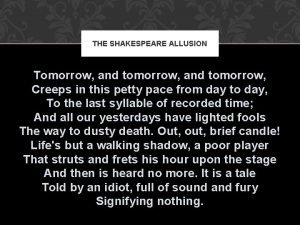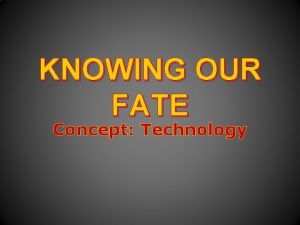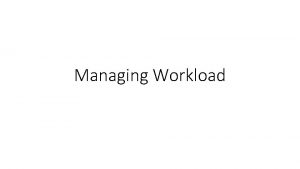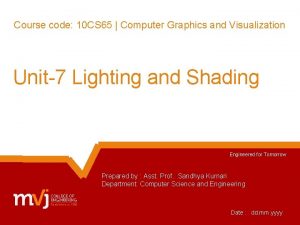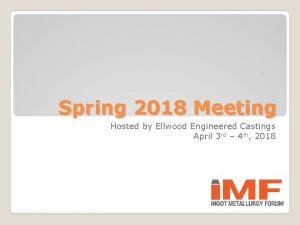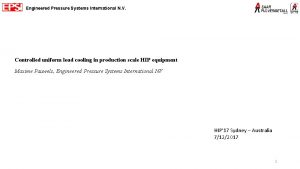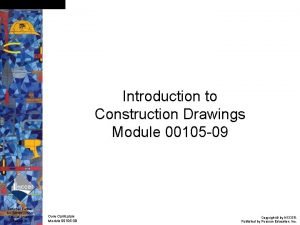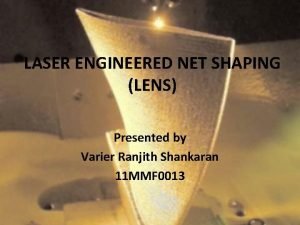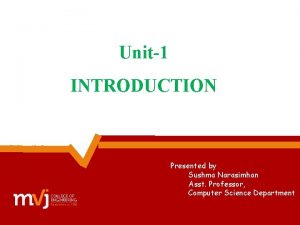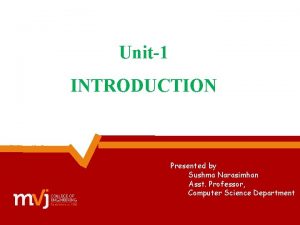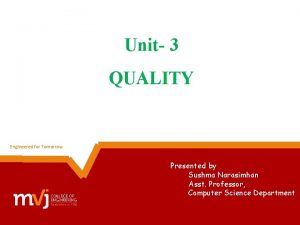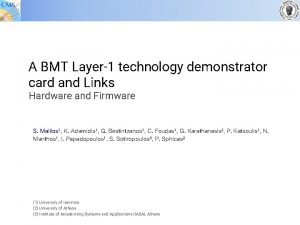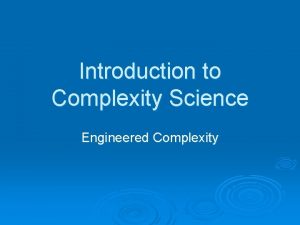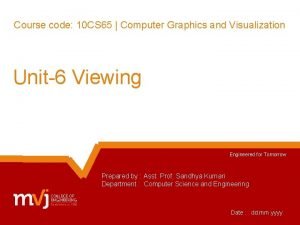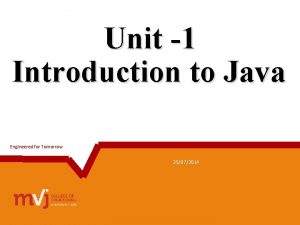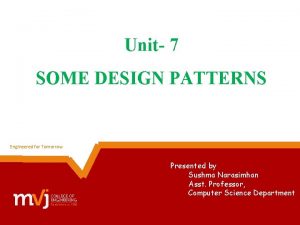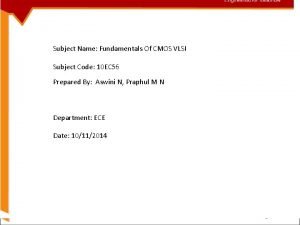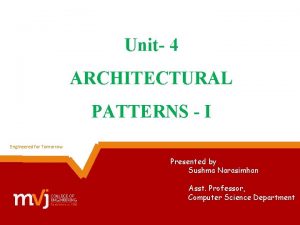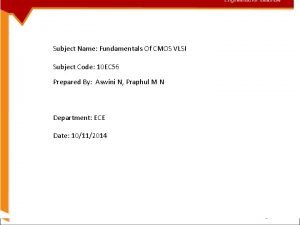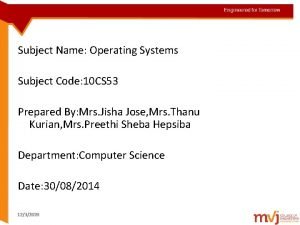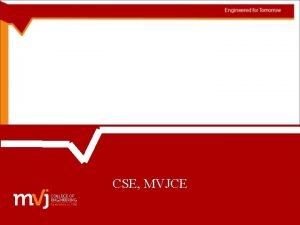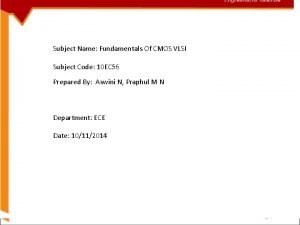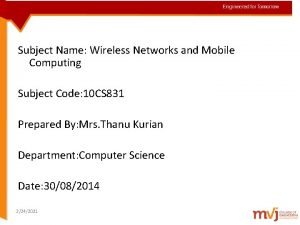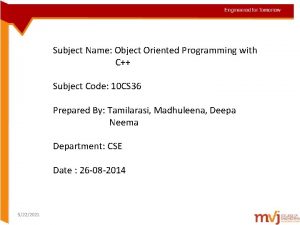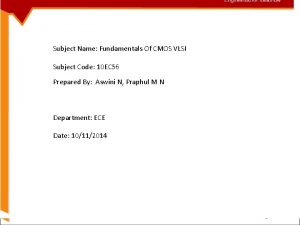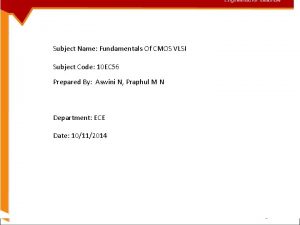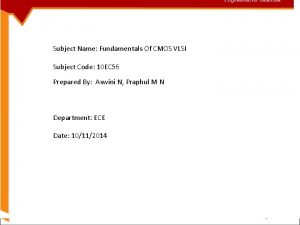Physical Layer1 Engineered for Tomorrow Engineered for Tomorrow













































































- Slides: 77

Physical Layer-1 Engineered for Tomorrow


Engineered for Tomorrow Analog vs. Digital Data • Analog data – Data take on continuous values – E. g. , human voice, temperature reading • Digital data – Data take on discrete values – E. g. , text, integers 3

Engineered for Tomorrow Analog vs. Digital Signals To be transmitted, data must be transformed to electromagnetic signals • Analog signals value – have an infinite number of values in a range • Digital signals – Have a limited number of values time value time 4

Engineered for Tomorrow • • Periodic and Non periodic Signals Both analog and digital signals can take one of two forms: periodic or non periodic. A periodic signal completes a pattern within a measurable time frame, called a period, and repeats that pattern over subsequent identical periods. The completion of one full pattern is called a cycle. A non periodic signal changes without exhibiting a pattern or cycle that repeats over time.

Engineered for Tomorrow Transmission Impairment • Attenuation • Distortion • Noise 6

Engineered for Tomorrow Signal Attenuation • Attenuation Loss of energy – Signal strength falls off with distance Transmission medium • Attenuation depends on medium • Attenuation is an increasing function of frequency 7

Engineered for Tomorrow Relative Signal Strength • Measured in Decibel (d. B) d. B = 10 log 10 (P 2/P 1) – P 1 and P 2 are signal powers at points 1 and 2, respectively Point 1 Point 2 – Positive d. B signal is amplified (gains strength) – Negative d. B signal is attenuated (loses strength) 8

Engineered for Tomorrow Example Sometimes the decibel is used to measure signal power in milliwatts. In this case, it is referred to as d. Bm and is calculated as d. Bm = 10 log 10 Pm , where Pm is the power in milliwatts. Calculate the power of a signal with d. Bm = − 30. Solution We can calculate the power in the signal as

Engineered for Tomorrow Signal Distortion • Distortion Change in signal shape – Only happens in guided media • Propagation velocity varies with frequency 10

Engineered for Tomorrow Noise • Noise Undesirable signals added between the transmitter and the receiver • Types of noise – Thermal • Due to random motion of electrons in a wire

Engineered for Tomorrow Noise • Types of noise (cont’d) – Crosstalk • Signal from one line picked up by another Wire 1 Wire 2 – Impulse • • Irregular pulses or spikes E. g. , lightning Short duration High amplitude 12

Engineered for Tomorrow Signal-to-Noise Ratio • Signal-to-Noise Ratio (SNR)

Engineered for Tomorrow Data Rate: Noiseless Channels • Nyquist Theorem Bit Rate = 2 × Bandwidth × log 2 L – Bit rate in bps – Bandwidth in Hz – L – number of signal levels Harry Nyquist (1889 -1976) 14

Engineered for Tomorrow Data Rate: Noisy Channels • Shannon Capacity = Bandwidth × log 2(1+SNR) – Capacity (maximum bit rate) in bps – Bandwidth in Hz – SNR – Signal-to-Noise Ratio Claude Elwood Shannon (1916 -2001) 15

Engineered for Tomorrow Example We have a channel with a 1 -MHz bandwidth. The SNR for this channel is 63. What are the appropriate bit rate and signal level? Solution First, use the Shannon capacity followed by the Nyquist formula 16

Engineered for Tomorrow Network Performance • Bandwidth – Hertz – Bits per second (bps) • Throughput – Actual data rate • Latency (delay) – Time it takes for an entire message to completely arrive at the destination 17

Engineered for Tomorrow Latency • Latency=propagation time+transmission time+queing time+processing delay • Propagation time=Distance/Propagation speed • Transmission time=Message size/bandwidth • Queuing time: It is the time needed for each intermediate or end device to hold the message before it can be processed. 18

Engineered for Tomorrow Latency Receiver Sender First bit leaves First bit arrives Propagation time Data bits Last bit leaves Transmission time Last bit arrives Time 19

Engineered for Tomorrow Bandwidth-Delay Product and Jitter Bandwidth-delay Product • The link is seen as a pipe – Cross section = bandwidth – Length = delay • Bandwidth-delay product defines the number of bits that can fill the link Jitter • Jitter is the variation in time between the packets arriving caused by network congestion, timing drift or route changes 20

Engineered for Tomorrow Digital to Digital Conversion In this section we see how we can represent digital data using digital signals. The conversion includes three techniques • Line coding • Block coding • Scrambling

Engineered for Tomorrow Line Coding • Process of converting binary data to digital signal 22

Engineered for Tomorrow Signal Levels vs. Data Levels • Number of signal levels – Number of different voltage levels allowed in a signal • Number of data levels – Number of voltage levels that actually represent data values 23

Engineered for Tomorrow Signal vs. Data Elements 24

Engineered for Tomorrow Pulse Rate vs. Bit Rate +3 00 11 01 10 11 00 +1 t -1 -3 One pulse (one signal element) Bit. Rate = Pulse. Rate × b = Pulse. Rate × log 2 L b – number of bits per pulse L – number of different signal elements Bit rate Bits per second Pulse rate Baud (pulses or signals per second) 25

Engineered for Tomorrow Encoding Considerations • Signal spectrum – Lack of DC components – Lack of high frequency components • • Clocking/synchronization Error detection Noise immunity Cost and complexity 26

Engineered for Tomorrow DC Components • DC components in signals are not desirable – Cannot pass thru certain devices – Leave extra (useless) energy on the line 0 0 1 1 0 0 1 t Signal with DC component t Signal without DC component 1 27

Engineered for Tomorrow Synchronization • To correctly decode a signal, receiver and sender must agree on bit interval 0 1 0 0 1 1 0 1 Sender sends: 01001101 t 0 1 0 0 0 1 1 t Receiver sees: 0100011011 28

Engineered for Tomorrow Line Coding Methods • Unipolar – Uses only one voltage level (one side of time axis) • Polar – Uses two voltage levels (negative and positive) – E. g. , NRZ, Manchester, Differential Manchester • Bipolar – Uses three voltage levels (+, 0, and –) for data bits • Multilevel 29

Engineered for Tomorrow Unipolar • Simplest form of digital encoding Rarely used • Only one polarity of voltage is used • E. g. , polarity assigned to 1 0 0 1 1 0 0 t 30

Engineered for Tomorrow Polar Encoding • Two voltage levels (+, -) represent data bits • Most popular four – – Nonreturn-to-Zero (NRZ) Return-to-Zero (RZ) Manchester Differential Manchester 31

Engineered for Tomorrow NRZ Encoding • Nonreturn to Zero – NRZ-L (NRZ-Level): Signal level depends on bit value 0 1 0 0 1 1 1 0 t – NRZ-I (NRZ-Invert): Signal is inverted if 1 is encountered 0 1 0 0 1 1 1 0 N = Bit rate Save = Average signal rate t 32

Engineered for Tomorrow RZ Encoding • Return to Zero – Uses three voltage levels: +, - and 0, but only + and - represent data bits – Half way thru each bit, signal returns to zero 0 1 0 0 1 1 0 0 t ? 33

Engineered for Tomorrow Manchester Encoding • Uses an inversion at the middle of each bit – For bit representation – For synchronization 0 1 0 0 1 1 0 =0 1 t =1 34

Engineered for Tomorrow Differential Manchester Encoding • The inversion on the middle of each bit is only for synchronization • Transition at the beginning of each bit tells the value 0 1 0 0 1 1 0 1 t 35

Engineered for Tomorrow Bipolar Encoding • Bipolar encoding uses three voltage levels: +, - and 0 • Each of all three levels represents a bit • E. g. , Bipolar AMI (Alternate Mark Inversion) – 0 V always represents binary 0 – Binary 1 s are represented by alternating + and - 0 1 0 0 1 1 0 1 t 36

Engineered for Tomorrow Bn. ZS Schemes • Bn. ZS – Bipolar n-zero substitution – Based on Bipolar AMI – n consecutive zeros are substituted with some +/- levels • provides synchronization during long sequence of 0 s – E. g. , B 8 ZS 1 1 0 0 0 0 Bipolar AMI B 8 ZS 1 1 0 0 0 1 0 t 0 0 0 V B V – Bipolar violation B – Valid bipolar signal 37

Engineered for Tomorrow Other Schemes • m. Bn. L – m data elements are substituted with n signal elements – E. g. , 2 B 1 Q (two binary, 1 quaternary) +3 00 11 01 10 11 00 +1 -1 -3 t Bit sequence Voltage level 00 01 10 11 -3 -1 +3 +1 38

Engineered for Tomorrow Block Coding • Improves the performance of line coding • Provides – Synchronization – Error detection Division … 01011010001… Substitution : 0010 1101 0001 : : 10110 01011 01010 : Line Coding t 39

Engineered for Tomorrow Scrambling • long sequence of 0 s upsets the synchronization. • • • Scambling is a technique that does not increase the number of bits and does provide synchronization. It substitutes long zero-level pulses with a combination of other levels to provide synchronization. We modify part of the AMI rule to include scrambling, as shown in the figure. Scrambling, as opposed to block coding, is done at the same time as encoding. The system needs to insert the required pulses based on the defined scrambling rules

Engineered for Tomorrow Analog to Digital Conversion • Pulse Amplitude Modulation (PAM) – Converts an analog signal into a series of pulses by sampling PAM Analog signal PAM signal (Sampled analog data) 41

Engineered for Tomorrow Pulse Code Modulation (PCM) • Converts an analog signal into a digital signal – PAM – Quantization – Binary encoding – Line coding 42

Engineered for Tomorrow PCM: Quantization • Converts continuous values of data to a finite number of discrete values 6 4 Output 2 0 1 2 3 4 Input 5 6 7 43

Engineered for Tomorrow Steps in quantization include: • We assume that the original analog signal has instantaneous amplitudes between Vmin and Vmax. • We divide the range into L zones, each of height Δ(delta). • We assign quantized values of 0 to L - 1 to the midpoint of each zone. • We approximate the value of the sample amplitude to the quantized values. • As a simple example, assume that we have a sampled signal and the sample amplitudes are between -20 and +20 V. We decide to have eight levels (L = 8). This means that Δ = 5 V.

Engineered for Tomorrow PCM: Quantization 45

Engineered for Tomorrow Quantization Error • Assume sine-wave input and uniform quantization – Known as the 6 d. B/bit approximation See also: http: //en. wikipedia. org/wiki/Quantization_error#Quantization_noise_model 46

Engineered for Tomorrow PCM: Binary Encoding • Maps discrete values to binary digits 47

Engineered for Tomorrow Original Signal Recovery The original signal is recovered using a PCM decoder.

Engineered for Tomorrow PCM Bandwidth • The minimum bandwidth of a line-encoded signal is • Bmin = c x N x (l/r). We substitute the value of N in this formula: • When 1/r = 1 (for a NRZ or bipolar signal) and c = (1/2) (the average situation), the minimum bandwidth is • This means the minimum bandwidth of the digital signal is nb times greater than the bandwidth of the analog signal

Engineered for Tomorrow PCM: The Whole Process 50

Engineered for Tomorrow Transmission Modes • We use the term transmission mode to refer to the manner in which data is sent over the underlying medium • Transmission modes can be divided into two fundamental categories: • Serial — one bit is sent at a time – Serial transmission is further categorized according to timing of transmissions • Parallel — multiple bits are sent at the same time 51 51

Engineered for Tomorrow Data Transmission and models 52

Engineered for Tomorrow Parallel Transmission • Parallel transmission allows transfers of multiple data bits at the same time over separate media • In general, parallel transmission is used with a wired medium that uses multiple, independent wires • Furthermore, the signals on all wires are synchronized so that a bit travels across each of the wires at precisely the same time • A parallel mode of transmission has two chief advantages: • High speed: It can send N bits at the same time a parallel interface can operate N times faster than an equivalent serial interface • Match to underlying hardware: Internally, computer and communication hardware uses parallel circuitry. A parallel interface matches the internal hardware well • Disadvantage : cost

Engineered for Tomorrow Parallel Transmission

Serial Transmission Engineered for Tomorrow • Sends one bit at a time • It may seem that anyone would choose parallel transmission for high speeds – However, most communication systems use serial mode • There are two main reasons – First, serial networks can be extended over long distances at much less cost – Second, using only one physical wire means that there is never a timing problem caused by one wire being slightly longer than another • Sender and receiver must contain a hardware that converts data from the parallel form used in the device to the serial form used on the wire

Engineered for Tomorrow Serial Transmission

Engineered for Tomorrow Serial Transmission • The advantage of serial over parallel transmission is that with only one communication channel, serial transmission reduces the cost of transmission over parallel by roughly a factor of n. • Serial transmission occurs in one of three ways: 1. Asynchronous 2. synchronous 3. isochronous

Engineered for Tomorrow Asynchronous Transmission Asynchronous communication is transmission of data, generally without the use of an external clock signal, where data can be transmitted intermittently rather than in a steady stream

Engineered for Tomorrow Synchronous Transmission In synchronous transmission data are transmitted as an unbroken string of 1 s and 0 s, and the receiver separates that string into the bytes, or characters, it needs to reconstruct the information

Engineered for Tomorrow Digital-to-Analog Conversion • Required to send digital data over a band-pass channel – Also known as modulation (band-pass channel) 60

Engineered for Tomorrow Conversion Techniques 61

Engineered for Tomorrow Amplitude Shift Keying In amplitude shift keying, the amplitude of the carrier signal is varied to create signal elements Binary Amplitude Shift Keying • Simplest form-on off keying fc – Carrier frequency 0 < d < 1 62

Engineered for Tomorrow Implementation of Binary ASK 63

Engineered for Tomorrow Full-Duplex ASK • Bandwidth can be divided into two to support full-duplex communication – Two carrier frequencies are used 64

Engineered for Tomorrow Frequency Shift Keying • Or Binary FSK 65

Engineered for Tomorrow Implementation of Binary FSK 66

Engineered for Tomorrow Multilevel FSK • Use one frequency to send more than one bit at a time • E. g. , the whole bandwidth divided into 8 frequency ranges 67

Engineered for Tomorrow Binary Phase Shift Keying • Or Binary PSK 68

Engineered for Tomorrow Implementation of Binary PSK 69

Engineered for Tomorrow Quadrature PSK • Each signal element carries 2 bits 70

Engineered for Tomorrow Implementation of QPSK 71

Engineered for Tomorrow Constellation Diagrams • A constellation diagram helps define the amplitude and phase of a signal element 72

Engineered for Tomorrow Example 5. 8 • Show the constellation diagrams for OOK, BPSK, and QPSK modulations 73

Engineered for Tomorrow Quadrature Amplitude Modulation • Or QAM • A combination of ASK and PSK 74

Engineered for Tomorrow

Engineered for Tomorrow

Engineered for Tomorrow
 Tomorrow and tomorrow creeps in this petty pace
Tomorrow and tomorrow creeps in this petty pace Tomorrow and tomorrow and tomorrow kurt vonnegut analysis
Tomorrow and tomorrow and tomorrow kurt vonnegut analysis Due tomorrow do tomorrow
Due tomorrow do tomorrow Due tomorrow do tomorrow
Due tomorrow do tomorrow Engineered shading
Engineered shading Engineered castings
Engineered castings Unit 7 engineered wood products
Unit 7 engineered wood products Ellwood engineered castings
Ellwood engineered castings What are engineered plans for motors called
What are engineered plans for motors called Engineered pressure systems
Engineered pressure systems Engineered in germany
Engineered in germany 00105-15 introduction to construction drawings
00105-15 introduction to construction drawings Lens laser engineered net shaping
Lens laser engineered net shaping Engineered wear solutions
Engineered wear solutions En lathund för arbete med kontinuitetshantering
En lathund för arbete med kontinuitetshantering Tobinskatten för och nackdelar
Tobinskatten för och nackdelar Egg för emanuel
Egg för emanuel Atmosfr
Atmosfr Biologiska arvet
Biologiska arvet Lågenergihus nyproduktion
Lågenergihus nyproduktion Presentera för publik crossboss
Presentera för publik crossboss Rbk-mätning
Rbk-mätning Var 1721 för stormaktssverige
Var 1721 för stormaktssverige Densitet vatten
Densitet vatten Tack för att ni lyssnade bild
Tack för att ni lyssnade bild Tack för att ni har lyssnat
Tack för att ni har lyssnat Smärtskolan kunskap för livet
Smärtskolan kunskap för livet Referatmarkering
Referatmarkering Start för skala
Start för skala Mjälthilus
Mjälthilus Autokratiskt ledarskap
Autokratiskt ledarskap Arkimedes princip formel
Arkimedes princip formel Vilka tal pekar pilarna på
Vilka tal pekar pilarna på Kassaregister ideell förening
Kassaregister ideell förening Toppslätskivling dos
Toppslätskivling dos Elektronik för barn
Elektronik för barn Borra hål för knoppar
Borra hål för knoppar Mat för idrottare
Mat för idrottare Bris för vuxna
Bris för vuxna Teckenspråk minoritetsspråk argument
Teckenspråk minoritetsspråk argument Ledarskapsteorier
Ledarskapsteorier Frgar
Frgar Ellika andolf
Ellika andolf Datorkunskap för nybörjare
Datorkunskap för nybörjare Steg för steg rita
Steg för steg rita Vad står k.r.å.k.a.n för
Vad står k.r.å.k.a.n för Redogör för vad psykologi är
Redogör för vad psykologi är Lek med geometriska former
Lek med geometriska former Claes martinsson
Claes martinsson Skriva i bunden form
Skriva i bunden form Nyckelkompetenser för livslångt lärande
Nyckelkompetenser för livslångt lärande Svenskt ramverk för digital samverkan
Svenskt ramverk för digital samverkan Antikt plagg
Antikt plagg Personlig tidbok för yrkesförare
Personlig tidbok för yrkesförare Handledning reflektionsmodellen
Handledning reflektionsmodellen Orubbliga rättigheter
Orubbliga rättigheter Verktyg för automatisering av utbetalningar
Verktyg för automatisering av utbetalningar Ministerstyre för och nackdelar
Ministerstyre för och nackdelar Big brother rösta
Big brother rösta Vem räknas som jude
Vem räknas som jude Hur stor skarns är det för ett barn att få cancer
Hur stor skarns är det för ett barn att få cancer Sju principer för tillitsbaserad styrning
Sju principer för tillitsbaserad styrning Romarriket tidslinje
Romarriket tidslinje Tack för att ni lyssnade bild
Tack för att ni lyssnade bild Ledningssystem för verksamhetsinformation
Ledningssystem för verksamhetsinformation Varför kallas perioden 1918-1939 för mellankrigstiden
Varför kallas perioden 1918-1939 för mellankrigstiden Borstål, egenskaper
Borstål, egenskaper Vishnuiter
Vishnuiter Centrum för kunskap och säkerhet
Centrum för kunskap och säkerhet Inköpsprocessen steg för steg
Inköpsprocessen steg för steg Påbyggnader för flakfordon
Påbyggnader för flakfordon Urban torhamn
Urban torhamn Strategi för svensk viltförvaltning
Strategi för svensk viltförvaltning A gastrica
A gastrica Typiska novell drag
Typiska novell drag Varians formel
Varians formel Rutin för avvikelsehantering
Rutin för avvikelsehantering Tack för att ni har lyssnat
Tack för att ni har lyssnat
